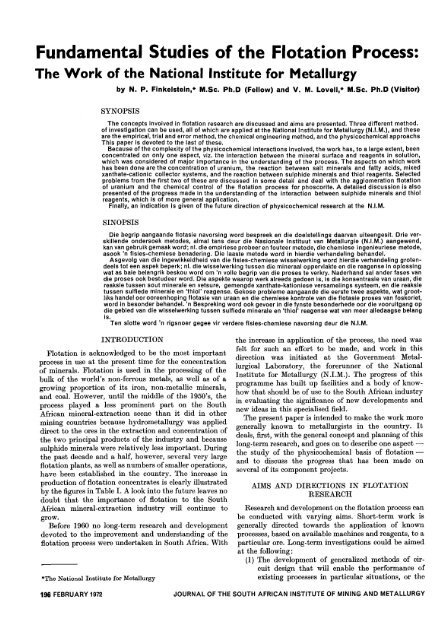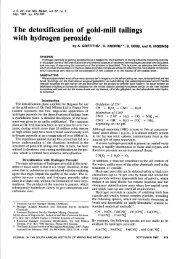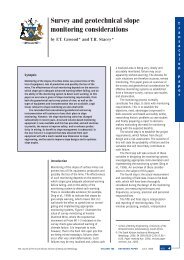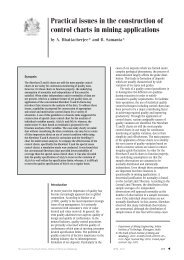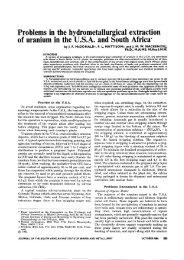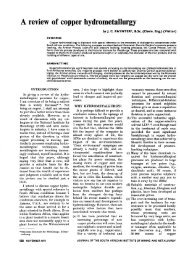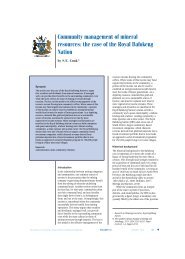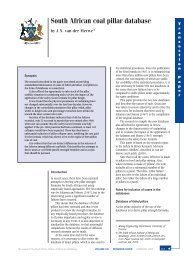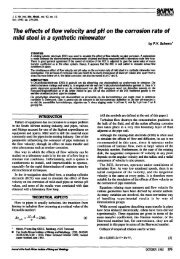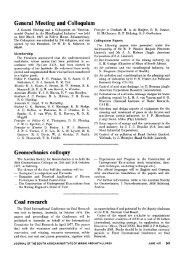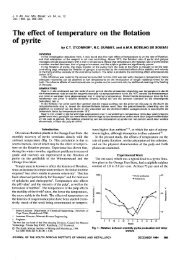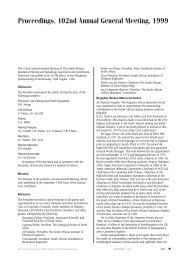Fundamental Studies of the Flotation Process: - saimm
Fundamental Studies of the Flotation Process: - saimm
Fundamental Studies of the Flotation Process: - saimm
Create successful ePaper yourself
Turn your PDF publications into a flip-book with our unique Google optimized e-Paper software.
<strong>Fundamental</strong> <strong>Studies</strong> <strong>of</strong> <strong>the</strong> <strong>Flotation</strong> <strong>Process</strong>:<br />
The Work <strong>of</strong> <strong>the</strong> National Institute for Metallurgy<br />
by N. P. Finkelstein,* M.Se. Ph.D (Fellow) and V. M. Lovell,* M.Se. Ph.D (Visitor)<br />
SYNOPSIS<br />
The concepts involved in flotation research are discussed and aims are presented. Three different method.<br />
<strong>of</strong> investigation can be used, all <strong>of</strong> which are applied at <strong>the</strong> National Institute for Metallurgy (N.I.M.), and <strong>the</strong>se<br />
are <strong>the</strong> empirical, trial and error method, <strong>the</strong> chemical engineering method, and <strong>the</strong> physicochemical approachs<br />
This paper is devoted to <strong>the</strong> last <strong>of</strong> <strong>the</strong>se.<br />
Because <strong>of</strong> <strong>the</strong> complexity <strong>of</strong> <strong>the</strong> physicochemical interactions involved, <strong>the</strong> work has, to a large extent, been<br />
concentrated on only one aspect, viz. <strong>the</strong> interaction between <strong>the</strong> mineral surface and reagents in solution,<br />
which was considered <strong>of</strong> major importance in <strong>the</strong> understanding <strong>of</strong> <strong>the</strong> process. The aspects on which work<br />
has been done are <strong>the</strong> concentration <strong>of</strong> uranium, <strong>the</strong> reaction between salt minerals and fatty acids, mixed<br />
xanthate-cationic collector systems, and <strong>the</strong> reaction between sulphide minerals and thiol reagents. Selected<br />
problems from <strong>the</strong> first two <strong>of</strong> <strong>the</strong>se are discussed in some detail and deal with <strong>the</strong> agglomeration flotation<br />
<strong>of</strong> uranium and <strong>the</strong> chemical control <strong>of</strong> <strong>the</strong> flotation process for phoscorite. A detailed discussion is also<br />
presented <strong>of</strong> <strong>the</strong> progress made in <strong>the</strong> understanding <strong>of</strong> <strong>the</strong> interaction between sulphide minerals and thiol<br />
reagents, which is <strong>of</strong> more general application.<br />
Finally, an indication is given <strong>of</strong> <strong>the</strong> future direction <strong>of</strong> physicochemical research at <strong>the</strong> N.I.M.<br />
SINOPSIS<br />
Die begrip aangaande flotasie navorsing word bespreek en die doelstellings daarvan uiteengesit. Drie verskillende<br />
ondersoek metodes, almal tans deur die Nasionale Instituut van Metallurgie (N.I.M.) aangewend,<br />
kan van gebruik gemaak word; nl. die empiriese probeer en fouteer metode, die chemiese ingenieuriese metode,<br />
asook 'n fisies-chemiese benadering. Die laaste metode word in hierdie verhandeling behandel.<br />
Asgevolg van die ingewikkeldheid van die fisies-chemiese wisselwerking word hierdie verhandeling grotendeels<br />
tot een aspek beperk; nl. die wisselwerking tussen die mineraal oppervlakte en die reagense in oplossing<br />
wat as baie belangrik beskou word om 'n volle begrip van die proses te verkry. Naderhand sal anderfases van<br />
die proses ook bestudeer word. Die aspekte waarop werk alreeds gedoen is, is die konsentrasie van uraan, die<br />
reaksie tussen gout minerale en vetsure, gemengde xanthate-kationiese versamelings systeem, en die reaksie<br />
tussen sulfiede minerale en 'thiol' reagense. Gekose probleme aangaande die eerste twee aspekte, wat grootliks<br />
handel oor ooreenhoping flotasie van uraan en die chemiese kontrole van die flotasie proses van foskoriet,<br />
word in besonder behandel. 'n Bespreking word ook gevoer in die fynste besonderhede oor die vooruitgang op<br />
die gebied van die wisselwerking tussen sulfiede minerale en 'thiol' reagense wat van meer alledaagse belang<br />
is.<br />
Ten slotte word 'n rigsnoer gegee vir verdere fisies-chemiese navorsing deur die N.I.M.<br />
INTRODUCTION<br />
<strong>Flotation</strong> is acknowledged to be <strong>the</strong> most important<br />
process in use at <strong>the</strong> present time for <strong>the</strong> concentration<br />
<strong>of</strong> minerals. <strong>Flotation</strong> is used in <strong>the</strong> processing <strong>of</strong> <strong>the</strong><br />
bulk <strong>of</strong> <strong>the</strong> world's non-ferrous metals, as well as <strong>of</strong> a<br />
growing proportion <strong>of</strong> its iron, non-metallic minerals,<br />
and coal. However, until <strong>the</strong> middle <strong>of</strong> <strong>the</strong> 1950's, <strong>the</strong><br />
process played a less prominent part on <strong>the</strong> South<br />
African mineral-extraction scene than it did in o<strong>the</strong>r<br />
mining countries because hydrometallurgy was applied<br />
direct to <strong>the</strong> ores in <strong>the</strong> extraction and concentration <strong>of</strong><br />
<strong>the</strong> two principal products <strong>of</strong> <strong>the</strong> industry and because<br />
sulphide minerals were relatively less important. During<br />
<strong>the</strong> past decade and a half, however, several very large<br />
flotation plants, as well as numbers <strong>of</strong> smaller operations,<br />
have been established in <strong>the</strong> country. The increase in<br />
production <strong>of</strong> flotation concentrates is clearly illustrated<br />
by <strong>the</strong> figures in Table 1. A look into <strong>the</strong> future leaves no<br />
doubt that <strong>the</strong> importance <strong>of</strong> flotation to <strong>the</strong> South<br />
African mineral-extraction industry will continue to<br />
grow.<br />
Before 1960 no long-term research and development<br />
devoted to <strong>the</strong> improvement and understanding <strong>of</strong> <strong>the</strong><br />
flotation process were undertaken in South Africa. With<br />
*The National Institute for Metallurgy<br />
<strong>the</strong> increase in application <strong>of</strong> <strong>the</strong> process, <strong>the</strong> need was<br />
felt for such an effort to be made, and work in this<br />
direction was initiated at <strong>the</strong> Government Metallurgical<br />
Laboratory, <strong>the</strong> forerunner <strong>of</strong> <strong>the</strong> National<br />
Institute for Metallurgy (N.1.M.). The progress <strong>of</strong> this<br />
programme has built up facilities and a body <strong>of</strong> knowhow<br />
that should be <strong>of</strong> use to <strong>the</strong> South African industry<br />
in evaluating <strong>the</strong> significance <strong>of</strong> new developments and<br />
new ideas in this specialised field.<br />
The present paper is intended to make <strong>the</strong> work more<br />
generally known to metallurgists in <strong>the</strong> country. It<br />
deals, first, with <strong>the</strong> general concept and planning <strong>of</strong> this<br />
long-term research, and goes on to describe one aspect -<br />
<strong>the</strong> study <strong>of</strong> <strong>the</strong> physicochemical basis <strong>of</strong> flotationand<br />
to discuss <strong>the</strong> progress that has been made on<br />
several <strong>of</strong> its component projects.<br />
AIMS AND DIRECTIONS IN FLOTATION<br />
RESEARCH<br />
Research and development on <strong>the</strong> flotation process can<br />
be conducted with varying aims. Short-term work is<br />
generally directed towards <strong>the</strong> application <strong>of</strong> known<br />
processes, based on available machines and reagents, to a<br />
particular ore. Long-term investigations could be aimed<br />
at <strong>the</strong> following:<br />
(1) The development <strong>of</strong> generalized methods <strong>of</strong> circuit<br />
design that will enable <strong>the</strong> performance <strong>of</strong><br />
existing processes in particular situations, or <strong>the</strong><br />
196 FEBRUARY 1972<br />
JOURNAL OF THE SOUTH AFRICAN INSTITUTE OF MINING AND<br />
METALLURGY
development <strong>of</strong> generalised methods for <strong>the</strong> control<br />
<strong>of</strong> flotation processes.<br />
(2) The extension <strong>of</strong> <strong>the</strong> scope <strong>of</strong> <strong>the</strong> process to<br />
combinations <strong>of</strong> minerals that are not readily<br />
separated to be optimized, to minerals that are not<br />
flotable with existing reagents, and to <strong>the</strong> coarse<br />
and fine sizes <strong>of</strong> particles that are less amenable<br />
to <strong>the</strong> process. Within this aim is included <strong>the</strong><br />
development <strong>of</strong> new reagents, new machines,<br />
and new techniques.<br />
(3) A more-complete understanding <strong>of</strong> <strong>the</strong> mechanism<br />
<strong>of</strong> <strong>the</strong> different processes taking place<br />
during flotation. Understanding <strong>of</strong> <strong>the</strong> physical and<br />
mechanical aspects could be <strong>of</strong> importance in<br />
fur<strong>the</strong>ring aim (1) above; <strong>the</strong> understanding <strong>of</strong><strong>the</strong><br />
chemical aspects would assist in realizing aim (2),<br />
and is essential to <strong>the</strong> solution <strong>of</strong> <strong>the</strong> important<br />
problem associated with <strong>the</strong> fact that nominally<br />
identical minerals can show significantly different<br />
behaviour in flotation.<br />
Three essentially different methods can be used in <strong>the</strong><br />
investigation <strong>of</strong> flotation. Firstly, <strong>the</strong> empirical (trialand-error)<br />
method in which previous experience is applied<br />
to new material by way <strong>of</strong> systematic process testing.<br />
For all its unwieldiness, this is <strong>the</strong> only technique by<br />
which processes can be developed and proved at <strong>the</strong><br />
present time. Secondly, <strong>the</strong> chemical-engineering method.<br />
This is a syn<strong>the</strong>tic approach that concentrates on <strong>the</strong><br />
mixing and transport aspects, and is designed to meet<br />
<strong>the</strong> first and, to a lesser extent, <strong>the</strong> second <strong>of</strong> <strong>the</strong> aims<br />
set out above. It seeks to characterize flotation as a rate<br />
process and express characteristics <strong>of</strong> a plant as a ma<strong>the</strong>matical<br />
model that relates all <strong>the</strong> most important<br />
factors governing <strong>the</strong> operation <strong>of</strong> <strong>the</strong> process. A satisfactory<br />
model would indicate how <strong>the</strong> process should be<br />
operated for greatest efficiency. Thirdly, <strong>the</strong> physicochemical<br />
approach. This analytical approach is directed<br />
towards <strong>the</strong> realization <strong>of</strong> both <strong>the</strong> second and third<br />
aims set out above. It is based on <strong>the</strong> premise that <strong>the</strong><br />
primary, if not <strong>the</strong> most important, factor governing <strong>the</strong><br />
efficiency and selectivity is <strong>the</strong> proper conditioning <strong>of</strong><br />
<strong>the</strong> solid-solution and air-solution interfaces so that<br />
collisions between <strong>the</strong>m are fruitful and selective. It<br />
<strong>the</strong>refore seeks to understand <strong>the</strong> nature and <strong>the</strong> mechanism<br />
<strong>of</strong> <strong>the</strong> chemical and physical reactions taking<br />
place at and between <strong>the</strong> interfaces.<br />
At <strong>the</strong> N.I.M. all three approaches are applied to <strong>the</strong><br />
study <strong>of</strong> flotation. The Ore Dressing Division carries out<br />
empirical development in relation to specific ores, <strong>the</strong><br />
University Research Group in <strong>the</strong> Department <strong>of</strong><br />
Chemical Engineering at <strong>the</strong> University <strong>of</strong> Natal concerns<br />
itself with an engineering approach based on<br />
ma<strong>the</strong>matical modelsl, and <strong>the</strong> Mineral and <strong>Process</strong><br />
Chemistry Division studies <strong>the</strong> physicochemical aspects<br />
<strong>of</strong> flotation.<br />
PHYSICOCHEMICAL RESEARCH WORK<br />
Fig. 1 presents a break-down <strong>of</strong> <strong>the</strong> flotation process in<br />
<strong>the</strong> form <strong>of</strong> a flow diagram, which shows <strong>the</strong> most important<br />
stages that take place and <strong>the</strong> interaction take<br />
over between <strong>the</strong>m. The process is manifestly a complex<br />
one. The heterogeneous mixture <strong>of</strong> solid particles that<br />
make up a typical flotation feed is concentrated and<br />
separated through interaction with chemical reagents,<br />
air, and energy. Important interactions take place at<br />
three interfaces-<strong>the</strong> solid-solution, solid-air, and airsolution<br />
interfaces-and in <strong>the</strong> solution phase.<br />
Before a detailed consideration <strong>of</strong> some <strong>of</strong> <strong>the</strong> various<br />
research projects that have been undertaken and are<br />
under way in <strong>the</strong> Mineral and <strong>Process</strong> Chemistry<br />
Division, it is necessary to explain <strong>the</strong> principles that<br />
have governed <strong>the</strong> general direction <strong>of</strong> <strong>the</strong> work.<br />
At <strong>the</strong> outset it was accepted that it would not be<br />
possible to work immediately on all stages <strong>of</strong> <strong>the</strong> process<br />
(c, d, e, and g <strong>of</strong> Fig. 1) in which important chemical<br />
interactions take place. It would be preferable to direct<br />
a concerted effort at one <strong>of</strong> <strong>the</strong> stages and to acquire on<br />
that one aspect a sound foundation <strong>of</strong> knowledge and<br />
experience on which a wider understanding could be<br />
built. Militating against a more general attack on <strong>the</strong><br />
subject was not only <strong>the</strong> considerable complexity <strong>of</strong> <strong>the</strong><br />
physicochemical interactions taking place, but also<br />
<strong>the</strong> uncertainties and contradictions in <strong>the</strong> existing<br />
knowledge <strong>of</strong> <strong>the</strong> subject - a circumstance that made it<br />
difficult to choose a secure point <strong>of</strong> knowledge from which<br />
to mount new research programmes.<br />
It was decided that all studies should be conducted on<br />
as rigid and quantative a basis as rigidly as possible. At<br />
<strong>the</strong> time <strong>the</strong> work was started, <strong>the</strong>re existed a certain<br />
general framework <strong>of</strong> understanding that explained,<br />
probably correctly, how hydrophobicity developed from<br />
<strong>the</strong> oriented absorption <strong>of</strong> collector molecules at <strong>the</strong><br />
mineral surface. However, this general understanding<br />
did not explain <strong>the</strong> processes taking place in sufficient<br />
detail to be <strong>of</strong> practical assistance in process design and<br />
control, or in <strong>the</strong> prediction <strong>of</strong> <strong>the</strong> behaviour <strong>of</strong> flotation<br />
systems. It was considered that fur<strong>the</strong>r progress would<br />
be possible only on <strong>the</strong> basis <strong>of</strong> a very much more quantitative<br />
and exact knowledge <strong>of</strong> <strong>the</strong> reactions taking<br />
place. The decision to adopt this type <strong>of</strong> very thorough<br />
approach carried with it <strong>the</strong> acceptance that <strong>the</strong> progress<br />
<strong>of</strong> <strong>the</strong> work might necessarily be slow and that, initially<br />
at least, <strong>the</strong> field <strong>of</strong> endeavour would have to be<br />
severely restricted.<br />
The aspect <strong>of</strong> <strong>the</strong> process chosen for initial study was<br />
<strong>the</strong> interaction between <strong>the</strong> mineral surface and reagents<br />
in solution (see Fig. 1, stage (d)), and <strong>the</strong> fields in which<br />
work has been carried out are shown in Fig. 2. The<br />
following sections describe a few <strong>of</strong> <strong>the</strong> specific problems<br />
that have been undertaken and <strong>the</strong> conclusions that have<br />
been reached will be outlined and placed in context with<br />
<strong>the</strong> general state <strong>of</strong> knowledge <strong>of</strong> <strong>the</strong> particular subject.<br />
THE INTERACTION BETWEEN SULPHIDE<br />
MINERALS AND THIOL REAGENTS14<br />
To place <strong>the</strong> work that has been done at N.I.M. in its<br />
context, it is necessary to summarize <strong>the</strong> general state <strong>of</strong><br />
knowledge <strong>of</strong> <strong>the</strong> interactions that take place between<br />
thiol reagents and sulphide minerals.<br />
By <strong>the</strong> early 1950's, a clear picture <strong>of</strong><strong>the</strong> events taking<br />
place when thiol reagents interact with sulphide mineral<br />
surfaces appeared to be emerging. It was known that<br />
sulphide surfaces abstracted thiols from aqueous<br />
solution and that in <strong>the</strong> process anions such as sulphates,<br />
JOURNAL OF THE SOUTH AFRICAN INSTITUTE OF MINING AND METALLURGY FEBRUARY 1972 197
(a)<br />
Comminution<br />
<strong>of</strong> minerals<br />
(b)<br />
Generation<br />
<strong>of</strong> air<br />
(c)<br />
Reactions <strong>of</strong> mineral<br />
surface with water<br />
(d)<br />
Reaction <strong>of</strong> mineral<br />
surface with<br />
reagents in solution<br />
(e)<br />
Reaction <strong>of</strong> air<br />
surface with<br />
reagents in water<br />
(f)<br />
Collision <strong>of</strong> particles<br />
with bubbles<br />
(g)<br />
Interaction between<br />
particle surface<br />
and bubbles<br />
Particle bubble<br />
aggregate<br />
Free particles<br />
Free bubbles<br />
Separation<br />
Froth<br />
Tailings<br />
Interaction between<br />
froth and tailings<br />
FIGURE 1 - Schematic flow diagram <strong>of</strong> flotation<br />
process<br />
198 FEBRUARY 1972<br />
JOURNAL OF THE SOUTH AFRICAN INSTITUTE OF MINING AND METALLURGY
I<br />
I<br />
CONCENTRATIONOF URANIUM<br />
Electrokinetic study Agglomeration Selective<br />
<strong>of</strong> Witwatersrand ores flotation flocculation<br />
Ref: 2 Ref: 3 Ref: 2<br />
I<br />
I<br />
I<br />
REACTION BETWEENSALT MINERALS AND FATTY ACIDS I<br />
I<br />
Surface distribution Adsorption Chemical control<br />
<strong>of</strong> oleates studies <strong>of</strong> flotation<br />
Ref: 4, 5, 6, 7 Ref: 4 <strong>of</strong> phoscorite<br />
Ref: 8<br />
I<br />
MIXED XANTHATE-CATIONIC COLLECTOR SYSTEMS<br />
Adduct formation<br />
Ref: 9,10,11,12<br />
<strong>Flotation</strong><br />
properties<br />
Ref: 13<br />
;<br />
I<br />
REACTION BETWEENSULPHIDE MINERALS AND THIOLS<br />
I<br />
1<br />
I T I 1<br />
Role <strong>of</strong> oxygen<br />
Homogeneous<br />
Products<br />
Activation<br />
Ref: 14,15,16, reactions <strong>of</strong> thiols and depression<br />
17,18,22<br />
Ref: 19,20 Ref: 9, 16,21,22<br />
I ~I<br />
I<br />
Galena with<br />
xanthate<br />
Metalsulp- Xanthate Catalyzed<br />
hides with stability oxidation<br />
xanthate<br />
<strong>of</strong> xanthates<br />
I 1<br />
Metal<br />
sulphide with<br />
thiols<br />
Sulphur as<br />
a product<br />
FIGURE 2 - Fields <strong>of</strong> physicochemical flotation studies<br />
JOURNAL OF THE SOUTH AFRICAN INSTITUTE OF MINING AND METALLURGY FEBRUARY1972199
hydroxides, or carbonates appeared in solution in<br />
equivalent quantities. The product <strong>of</strong> <strong>the</strong> reaction was<br />
considered to be <strong>the</strong> metal-thiolate, and it was tacitly<br />
assumed that this adsorbed regularly, layer by layer.<br />
There was some evidence that <strong>the</strong> first layer was more<br />
strongly held than <strong>the</strong> subsequent ones. The reaction<br />
was generally regarded as one that rapidly reached a<br />
reversible state <strong>of</strong> equilibrium. This conclusion carries<br />
<strong>the</strong> important implication that <strong>the</strong> state <strong>of</strong> <strong>the</strong> surface is<br />
uniquely related to <strong>the</strong> state <strong>of</strong> <strong>the</strong> solution - concentrations<br />
<strong>of</strong> different ions, pH, temperature, etc.-with<br />
which it is in contact. There was some controversy<br />
whe<strong>the</strong>r clean sulphidemineral surfaces were floatable,<br />
but it was accepted that <strong>the</strong> surfaces encountered in<br />
practice would, to a greater or lesser extent, be oxidized<br />
and that this would make <strong>the</strong>m hydrophilic. It was<br />
thought that hydrophobic properties were conferred on<br />
such surfaces by <strong>the</strong> adsorbed metal xanthates that were<br />
known to be so oriented that <strong>the</strong> hydrocarbon portion<br />
extended away from <strong>the</strong> solid and into solution.<br />
During <strong>the</strong> mid 1950's facts began to accumulate that<br />
were not in harmony with this picture. The doubts<br />
crystallized around <strong>the</strong> work <strong>of</strong> <strong>the</strong> Russian school, which<br />
published a series <strong>of</strong> imported papers at about this time.<br />
These showed that <strong>the</strong> presence <strong>of</strong> oxygen was essential<br />
if <strong>the</strong>re was to be reaction between sulphide minerals and<br />
thiol reagents, and if <strong>the</strong> minerals were to be rendered<br />
flotable. , They also showed that <strong>the</strong> disposition <strong>of</strong> <strong>the</strong><br />
adsorbed reagents at <strong>the</strong> surface, far from being regular,<br />
consisted <strong>of</strong> a number <strong>of</strong> isolated multilayer patches. It<br />
was suggested that <strong>the</strong> adsorption <strong>of</strong> reagent was controlled<br />
by <strong>the</strong> semiconductor properties <strong>of</strong> <strong>the</strong> surface,<br />
which were favourably influenced by interaction with<br />
oxygen.<br />
During <strong>the</strong> past ten to fifteen years, a number <strong>of</strong><br />
investigations have been undertaken in which sophisticated<br />
modern techniques have been applied to <strong>the</strong> study<br />
<strong>of</strong> <strong>the</strong> chemistry <strong>of</strong> <strong>the</strong>se interactions. These investigations<br />
have concentrated on <strong>the</strong> following problems.<br />
(i) How does oxygen participate in <strong>the</strong> interaction<br />
between thiol reagents and sulphide minerals?<br />
(ii) What are <strong>the</strong> products <strong>of</strong>reaction?<br />
(iii) What makes <strong>the</strong> surface flotable after reaction<br />
with thiols?<br />
The work programme <strong>of</strong> N.I.M. has been directed<br />
primarily at <strong>the</strong> first and second <strong>of</strong> <strong>the</strong>se problems.<br />
THE ROLE OF OXYGEN IN THE INTERACTION<br />
BETWEEN XANTHATE AND GALENA15, 16, 17, 18, 22<br />
One <strong>of</strong> <strong>the</strong> mechanisms that have been proposed to<br />
account for <strong>the</strong> participation <strong>of</strong> oxygen in <strong>the</strong> interaction<br />
between xanthates and sulphide minerals involves<br />
<strong>the</strong> oxidation <strong>of</strong> xanthate by oxygen in solution to form<br />
dixanthogen, which <strong>the</strong>n adsorbs and reacts at <strong>the</strong><br />
surface:<br />
2X--I-t02-1-H2O<br />
---+X2-1-20H-<br />
IPbS -I-X2 ---+ I PbS - Surface Products<br />
A series <strong>of</strong> simple experiments showed that this<br />
mechanism could be eliminated from consideration. The<br />
rate <strong>of</strong> decomposition <strong>of</strong> xanthates in pure, alkaline<br />
solutions was found to be <strong>the</strong> same in <strong>the</strong> presence and<br />
in <strong>the</strong> absence <strong>of</strong> dissolved oxygen, and no dixanthogen<br />
could be detected among <strong>the</strong> products <strong>of</strong> decomposition.<br />
Reaction with oxygen and <strong>the</strong> formation <strong>of</strong> dixanthogen<br />
was found to be catalysed by <strong>the</strong> presence <strong>of</strong> ions <strong>of</strong><br />
several transition metals. (See Table HI). However, <strong>the</strong><br />
rate <strong>of</strong> <strong>the</strong> catalysed formation <strong>of</strong> dixanthogen was too<br />
low for it to be <strong>of</strong> importance in flotation, where all<br />
reaction must take place within a few minutes.<br />
It is clear, <strong>the</strong>refore, that oxygen must play its role by<br />
direct action at <strong>the</strong> mineral surface. There are essentially<br />
two ways by which this interaction might take place.<br />
The first <strong>of</strong> <strong>the</strong>se involves <strong>the</strong> oxidation <strong>of</strong> <strong>the</strong> surface to<br />
form insoluble products that subsequently undergo an<br />
exchange with xanthate ions from solution, for example,<br />
I PbS-\-202 ---+ IPbS04<br />
I PbS04-1-2X- ---+ IPbX2.<br />
It has been convincingly demonstrated29, 30 that<br />
xanthate can react with heavily oxidized surfaces in<br />
this way, but this does not preclude <strong>the</strong> second direct<br />
mechanism - <strong>the</strong> simultaneous interaction <strong>of</strong> xanthate<br />
and oxygen at <strong>the</strong> surface - which may be written<br />
schematically as follows:<br />
IPbS-I-O 2-I-nX- ---+ I PbS Surface -I- Solution<br />
product(s) product(s)<br />
The N.I.M. group has devoted a major effort to <strong>the</strong><br />
elucidation <strong>of</strong> this mechanism and has concentrated on<br />
galena and ethyl xanthate as a model system. This<br />
investigation is one <strong>of</strong> considerable experimental<br />
difficulty, which stems from two sources: firstly, <strong>the</strong><br />
requirement that <strong>the</strong> sulphide surfaces used should be<br />
free <strong>of</strong> oxidation initially and, secondly, <strong>the</strong> need for <strong>the</strong><br />
concentration <strong>of</strong> oxygen in <strong>the</strong> reaction system to be<br />
controlled and measured, and for <strong>the</strong> system to be<br />
isolated from contact with <strong>the</strong> abundant oxygen <strong>of</strong> <strong>the</strong><br />
surrounding atmosphere. Thus, <strong>the</strong> progress <strong>of</strong> <strong>the</strong><br />
investigation is conveniently followed through <strong>the</strong><br />
development <strong>of</strong> experimental techniques.<br />
The first stage <strong>of</strong> <strong>the</strong> investigation was <strong>the</strong> development<br />
<strong>of</strong> a means by which oxidation products could be<br />
removed from <strong>the</strong> surface <strong>of</strong> a sample <strong>of</strong> ground galena<br />
and by which <strong>the</strong> surface could subsequently be contacted<br />
with solutions containing ei<strong>the</strong>r no oxygen or<br />
some oxygen16. The apparatus consisted essentially <strong>of</strong> a<br />
column through which solutions flowed upwards, maintaining<br />
a bed <strong>of</strong> ground galena in fluidized condition.<br />
Contact with sodium sulphide solution at pH 8, followed<br />
by rinsing with water, was found to effectively free <strong>the</strong><br />
surface <strong>of</strong> oxidation: <strong>the</strong> resulting 'clean' surface did<br />
not react with an oxygen-free xanthate solution. As<br />
expected, when oxygen was introduced to <strong>the</strong> xanthate<br />
solution, reaction between xanthate and <strong>the</strong> surface, as<br />
indicated by a decrease in concentration <strong>of</strong> xanthate in<br />
solution, was observed. Quite unexpected, however, was<br />
<strong>the</strong> observation that this reaction did not reach completion<br />
after a time, as would be expected if it was<br />
limited by <strong>the</strong> build-up <strong>of</strong> a layer <strong>of</strong> adsorbed product on<br />
<strong>the</strong> surface. On <strong>the</strong> contrary, reaction persisted for as<br />
long - and experiments extended over several daysas<br />
oxygen and xanthate were kept in contact with <strong>the</strong><br />
mineral surface.<br />
200 FEBRUARY 1972 JOURNAL OF THE SOUTH AFRICAN INSTITUTE OF MINING AND METALLURGY
The finding that <strong>the</strong> abstraction <strong>of</strong> xanthate by galena<br />
is a continuing process that does not reach completion or<br />
equilibrium is <strong>of</strong> <strong>the</strong> greatest importance and has<br />
necessarily influenced <strong>the</strong> course <strong>of</strong> subsequent work. It<br />
implies that <strong>the</strong> reaction is not reversible and that <strong>the</strong><br />
extent <strong>of</strong> reaction is no longer a primary parameter that<br />
can be related simply to such variables as <strong>the</strong> concentrations<br />
<strong>of</strong> xanthate and <strong>of</strong> oxygen, pH, and temperature.<br />
The system can effectively be studied only with<br />
reference to <strong>the</strong> kinetics <strong>of</strong> reaction. Therefore, <strong>the</strong> next<br />
stage <strong>of</strong> <strong>the</strong> work emphasized <strong>the</strong> determination <strong>of</strong><br />
rates <strong>of</strong> reaction.<br />
The second stage <strong>of</strong> development was carried out with<br />
an apparatus17 shown in Fig. 3 that was similar to that<br />
used previously, in that solutions having passed through<br />
a fluid bed <strong>of</strong> mineral were analysed for <strong>the</strong>ir xanthate<br />
content and <strong>the</strong>n discarded. However, provision was<br />
made for <strong>the</strong> concentration <strong>of</strong> oxygen in <strong>the</strong> entering<br />
solution to be precisely controlled. It was found17 that<br />
two distinct reactions between xanthate, oxygen, and<br />
galena could be distinguished. The first <strong>of</strong> <strong>the</strong>se results<br />
in <strong>the</strong> adsorption <strong>of</strong> xanthate, and <strong>the</strong> second gives rise<br />
to soluble products. The adsorption reaction predominates<br />
in <strong>the</strong> early stages <strong>of</strong> contact between oxygencontaining<br />
xanthate solutions and 'clean' galena, and<br />
follows an exponential rate equation:<br />
dqfdt=f3 expo (-aq),<br />
where q is <strong>the</strong> quantity <strong>of</strong> xanthate adsorbed and a and<br />
f3 are constants. At any time, both <strong>the</strong> rate and <strong>the</strong> extent<br />
<strong>of</strong> adsorption vary directly with <strong>the</strong> square root <strong>of</strong><br />
<strong>the</strong> partial pressure <strong>of</strong> oxygen in solution. The second<br />
type <strong>of</strong> reaction becomes predominant once <strong>the</strong> rate <strong>of</strong><br />
adsorption has been sufficiently reduced by <strong>the</strong> accumulation<br />
<strong>of</strong> adsorption products. This reaction is responsible<br />
for <strong>the</strong> continuing abstraction <strong>of</strong> xanthate from solution,<br />
which had been noted in <strong>the</strong> first stages <strong>of</strong> experimentation.<br />
After several hours <strong>of</strong> contact between <strong>the</strong> surface<br />
and <strong>the</strong> reagent, this reaction proceeds at a constant<br />
rate, which also varies with <strong>the</strong> square root <strong>of</strong> <strong>the</strong> partial<br />
pressure <strong>of</strong> oxygen in solution. Although it was not found<br />
possible to identify <strong>the</strong> chemical changes taking place, it<br />
was noted that <strong>the</strong> reaction was associated with <strong>the</strong><br />
appearance <strong>of</strong> a water-soluble product that was tentatively<br />
identified as <strong>the</strong> monothiocarbonate ROCOS-.<br />
It can be seen that this substance can be obtained from<br />
<strong>the</strong> equivalent xanthate, ROCS;, by replacement <strong>of</strong><br />
one <strong>of</strong> <strong>the</strong> sulphur atoms with oxygen.<br />
The design <strong>of</strong> <strong>the</strong> second apparatus did not allow<br />
meaningful observations to be made within <strong>the</strong> first<br />
20 minutes <strong>of</strong> contact between <strong>the</strong> solutions and <strong>the</strong><br />
mineral. This meant that <strong>the</strong> results do not apply to <strong>the</strong><br />
reactions that are <strong>of</strong> primary importance in flotation.<br />
Accordingly, attention was focused on <strong>the</strong> development<br />
<strong>of</strong> an apparatus that would allow this early period to be<br />
studied, and would also allow <strong>the</strong> consumption <strong>of</strong><br />
oxygen during reaction to be monitored. After a prolonged<br />
period <strong>of</strong> unsuccessful innovation, <strong>the</strong> apparatus<br />
shown in Fig. 4 was developed31. In use, suitably pretreated<br />
galena is dropped into <strong>the</strong> upward-flow column,<br />
which contains a solution <strong>of</strong> <strong>the</strong> reagents that are required<br />
for <strong>the</strong> particular experiment. The column is <strong>the</strong>n<br />
sealed in closed circuit with a spectrophotometer cell for<br />
determining <strong>the</strong> concentration <strong>of</strong> xanthate, a Clark<br />
electrode for monitoring <strong>the</strong> concentration <strong>of</strong> dissolved<br />
oxygen, and a completely sealed glass centrifugal pump.<br />
This system is capable <strong>of</strong> yielding meaningful results<br />
within 2 minutes <strong>of</strong> <strong>the</strong> commencement <strong>of</strong> reaction and<br />
has proved itself to be extremely productive. The<br />
results are very much more reproducible than those<br />
obtained by <strong>the</strong> previous techniques.<br />
Whereas numbers <strong>of</strong> reliable observations have been<br />
made by this technique, <strong>the</strong> work <strong>of</strong> interpretation is<br />
still in progress. At this time, however, a number <strong>of</strong><br />
interesting findings can be mentioned.<br />
1. The two stages <strong>of</strong> reaction, which are again<br />
clearly revealed, are characterized by different<br />
values <strong>of</strong> <strong>the</strong> stoichiometric ratio - number <strong>of</strong><br />
molecules <strong>of</strong> xanthate reacted to number <strong>of</strong><br />
molecules <strong>of</strong> oxygen reacted. The ratio has a value<br />
<strong>of</strong> two in <strong>the</strong> first stage <strong>of</strong> reaction and, depending<br />
on <strong>the</strong> conditions, varying values <strong>of</strong> less than one<br />
in <strong>the</strong> second stage.<br />
2. Clear confirmation was obtained that <strong>the</strong> final,<br />
continuing stage <strong>of</strong> <strong>the</strong> abstraction <strong>of</strong> xanthate is<br />
due to <strong>the</strong> formation <strong>of</strong> monothiocarbonate.<br />
3. Under certain conditions <strong>of</strong> pH and xanthate<br />
concentration, adsorbed xanthate is converted to<br />
monothiocarbonate (MTC-) at <strong>the</strong> surface, which<br />
<strong>the</strong>n desorbs. It is thought that this effect might<br />
take place by reaction between adsorbed lead<br />
xanthate and lead hydroxide:<br />
Pb(OHh+PbX2+20H + 2MTC- +2PbS+~O.<br />
4. The new experimental technique allows <strong>the</strong><br />
quantity <strong>of</strong> monothiocarbonate formed at any<br />
time to be accurately determined and, <strong>the</strong>refore,<br />
<strong>the</strong> amount <strong>of</strong> xanthate adsorbed at <strong>the</strong> surface to<br />
be estimated. Thus it has been shown that <strong>the</strong><br />
adsorption <strong>of</strong> xanthate can be reversed if suitable<br />
adjustments are made to <strong>the</strong> concentration or pH<br />
<strong>of</strong> <strong>the</strong> solution with which it is in contact. Whereas<br />
it is not yet certain how quantitative and complete<br />
this reversibility is, it seems highly probable<br />
that former indications <strong>of</strong> <strong>the</strong> adsorption <strong>of</strong><br />
xanthate as irreversible derived from confusion<br />
between adsorption and <strong>the</strong> side reaction by which<br />
xanthate is converted to monothiocarbonateand<br />
<strong>the</strong> latter certainly could not be reversed<br />
under <strong>the</strong> conditions obtaining in flotation.<br />
5. The total rate <strong>of</strong> consumption <strong>of</strong> oxygen by<br />
galena is decreased by <strong>the</strong> presence <strong>of</strong> xanthate.<br />
PRODUCTS OF REACTION BETWEEN THIOLS<br />
AND METAL SULPHIDES19, 20<br />
The investigation <strong>of</strong> <strong>the</strong> nature <strong>of</strong> <strong>the</strong> products <strong>of</strong><br />
reaction was prompted by <strong>the</strong> controversy that has<br />
grown up in <strong>the</strong> literature between those authors who<br />
believe <strong>the</strong> product <strong>of</strong> reaction between xanthates and<br />
sulphide minerals to be <strong>the</strong> metal xanthate, those who<br />
believe it to be dixanthogen, and those who believe it<br />
to be a mixture <strong>of</strong> <strong>the</strong> two. In <strong>the</strong> case <strong>of</strong> galena, <strong>the</strong><br />
most convincing piece <strong>of</strong> evidence in favour <strong>of</strong> dixanthogen<br />
was provided by <strong>the</strong> work <strong>of</strong> Abramov32, who<br />
used infrared spectroscopy to identify <strong>the</strong> products extracted<br />
from <strong>the</strong> surface <strong>of</strong> xanthated galena. When<br />
JOURNAL OF THE SOUTH AFRICAN INSTITUTE OF MINING AND METALLURGY FEBRUARY 1972 201
members <strong>of</strong> <strong>the</strong> N.I.M. team repeated this work, <strong>the</strong>y<br />
were unable to identify dixanthogen in extracts from<br />
xanthate- treated galena surfaces but, instead, found only<br />
lead xanthate to be present. Fur<strong>the</strong>r investigation <strong>of</strong> <strong>the</strong><br />
detailed procedure used by Abramov revealed that one<br />
<strong>of</strong> its stages - <strong>the</strong> evaporation <strong>of</strong> <strong>the</strong> organic extract<br />
from <strong>the</strong> mineral surface - had <strong>the</strong> effect <strong>of</strong> converting<br />
any lead xanthate present to dixanthogen and showed<br />
Abramov's finding to be an experimental artifact. It<br />
was <strong>the</strong>refore confidently concluded that metal xanthate<br />
was a major product <strong>of</strong> <strong>the</strong> reaction between galena and<br />
xanthate solutions. Since dixanthogen is more soluble<br />
than lead xanthate in <strong>the</strong> solvents used, and since <strong>the</strong>re<br />
is no reason to believe that it is more strongly held at<br />
<strong>the</strong> surface than is <strong>the</strong> lead xanthate, it was also concluded<br />
that dixanthogen is not a major product. However,<br />
it could not be concluded that lead xanthate was<br />
<strong>the</strong> only product <strong>of</strong> reaction because <strong>the</strong>re was no assurance<br />
that all <strong>the</strong> products formed at <strong>the</strong> surface were<br />
extracted by <strong>the</strong> methods used.<br />
The investigation was extended to <strong>the</strong> determination<br />
<strong>of</strong> <strong>the</strong> products <strong>of</strong> reaction between some twelve different<br />
sulphide minerals and several different xanthate homologues.<br />
The purpose <strong>of</strong> this work was to establish<br />
whe<strong>the</strong>r <strong>the</strong> different minerals would form <strong>the</strong> same<br />
type <strong>of</strong> product (metal xanthate or dixanthogen) and to<br />
see whe<strong>the</strong>r any observed differences could be explained.<br />
The results, which are summarized in Table IV,<br />
show that, where minerals react to form an extractable<br />
product, this product tends to be ei<strong>the</strong>r metal xanthate<br />
or dixanthogen. The formation <strong>of</strong> mixtures <strong>of</strong> <strong>the</strong> two is a<br />
rarity. Which <strong>of</strong> <strong>the</strong> two products is formed correlates<br />
with <strong>the</strong> potential that <strong>the</strong> mineral assumes in a solution<br />
<strong>of</strong> <strong>the</strong> xanthate. Those minerals that take up a potential<br />
more positive than <strong>the</strong> equilibrium potential for <strong>the</strong><br />
reaction<br />
X2+2e-+2Xform<br />
dixanthogen; those that assume a more negative<br />
potential ei<strong>the</strong>r form <strong>the</strong> metal xanthate or do not react.<br />
The reactions between <strong>the</strong> same suite <strong>of</strong> minerals and<br />
different types <strong>of</strong> thiol flotation reagents are currently<br />
being studied. The reagents are mercaptobenzthiazole,<br />
and alkyl dithiophosphates, thiocarbamates, and thionocarbamates.<br />
Results are being obtained that are in<br />
harmony with <strong>the</strong> behaviour observed in reaction with<br />
xanthates. Again it is found that, where reaction takes<br />
place, it is ei<strong>the</strong>r <strong>the</strong> metal thiolate or <strong>the</strong> dithiolate that<br />
is formed; and, again, <strong>the</strong> formation <strong>of</strong> <strong>the</strong> dithiolate<br />
takes place on those minerals that assume a potential in a<br />
solution <strong>of</strong> <strong>the</strong> reagent that is higher than <strong>the</strong> equilibrium<br />
potential for <strong>the</strong> appropriate reduction reaction.<br />
Although this work has provided an overall view <strong>of</strong> <strong>the</strong><br />
behaviour <strong>of</strong> a number <strong>of</strong> related reagents with a whole<br />
range <strong>of</strong> metal sulphide minerals, and has thrown some<br />
light on a controversial subject, it by no means provides a<br />
complete pr an adequate understanding <strong>of</strong> <strong>the</strong> products<br />
that are formed at <strong>the</strong> mineral surface. There is evidence<br />
that some minerals, at least, form a tightly-bound thiolcontaining<br />
product that is not amenable to extraction<br />
by common organic solvents and hence cannot be detected<br />
by; <strong>the</strong> techniques used at <strong>the</strong> N.I.M. For galena<br />
and xanthate, this product is thought to be a species in<br />
which a surface lead atom is attached to one xanthate,<br />
instead <strong>of</strong> to <strong>the</strong> normal two xanthates. Fur<strong>the</strong>rmore,<br />
<strong>the</strong>re is reason to suspect that elementary sulphur is always<br />
formed as a primary product <strong>of</strong> <strong>the</strong> reaction between<br />
oxygen and sulphide surfaces in <strong>the</strong> presence <strong>of</strong><br />
thiol reagents and that this sulphur may play an important<br />
part in rendering <strong>the</strong> sulphide mineral surfaces<br />
floatable.<br />
THE<br />
CAUSE OF FLOATIBILITY<br />
Both <strong>the</strong> metal xanthate and dixanthogen have been<br />
suggested as <strong>the</strong> entities that confer hydrophobic<br />
properties on sulphide mineral surfaces after <strong>the</strong>y have<br />
been treated with xanthate. The finding that sulphide<br />
minerals react with xanthates to produce, in general,<br />
ei<strong>the</strong>r xanthate or dixanthogen makes it extremely<br />
unlikely that ei<strong>the</strong>r <strong>of</strong> <strong>the</strong>se can be <strong>the</strong> sole cause <strong>of</strong><br />
hydrophobicity at sulphide surfaces after treatment with<br />
xanthates. Indeed, it is now not even certain that ei<strong>the</strong>r<br />
<strong>of</strong> <strong>the</strong>m need necessarily be <strong>the</strong> primary hydrophobic<br />
entity. In an attempt to explain <strong>the</strong>ir observations on<br />
<strong>the</strong> role <strong>of</strong> oxygen, <strong>the</strong> workers at N.I.M. have been led<br />
to postulate reactions in which elemental sulphur is<br />
always one <strong>of</strong> <strong>the</strong> products - whe<strong>the</strong>r <strong>the</strong> reaction is<br />
adsorption or <strong>the</strong> formation <strong>of</strong> monothiocarbonate. The<br />
question now arises whe<strong>the</strong>r sulphur can be ei<strong>the</strong>r solely<br />
or partly responsible for hydrophobicity. Whereas <strong>the</strong><br />
suggestion is by no means a new one and some objections<br />
to it have been proposed, it is thought to warrant reexamination.<br />
AGGLOMERATION FLOTATION OF URANIUM-<br />
BEARING ORES2. 3<br />
For some time, interest has been shown by <strong>the</strong> mining<br />
industry in <strong>the</strong> development <strong>of</strong> processes for <strong>the</strong> concentration<br />
<strong>of</strong> uranium from minerals present in Witwatersrand<br />
ores. That none <strong>of</strong> <strong>the</strong> processes thus far<br />
proposed has been adopted might be ascribed to <strong>the</strong>ir<br />
failure to recover <strong>the</strong> uranium values that are associated<br />
with <strong>the</strong> finer particle sizes. Much <strong>of</strong> <strong>the</strong> uranium occurs<br />
in <strong>the</strong> slime fractions as is shown in Table n, which<br />
gives <strong>the</strong> analyses <strong>of</strong> <strong>the</strong> various size fractions from a<br />
sample <strong>of</strong> ore from Western Deep Levels, and which<br />
shows that 23 per cent <strong>of</strong> <strong>the</strong> uranium is associated with<br />
<strong>the</strong> fraction smaller than 12 /Lm. The uranium in <strong>the</strong> ores<br />
is usually associated with <strong>the</strong> phyllosilicate fraction<br />
(which limits <strong>the</strong> extent <strong>of</strong> beneficiation that is possible),<br />
and <strong>the</strong> concentration problem <strong>the</strong>refore resolves itself<br />
into <strong>the</strong> separation <strong>of</strong> <strong>the</strong> phyllosilicates from <strong>the</strong> quartz<br />
gangue.<br />
It was decided to try a new approach that would take<br />
into account <strong>the</strong> special requirements <strong>of</strong> <strong>the</strong> slime<br />
fractions. This approach was based on <strong>the</strong> principle that<br />
<strong>the</strong> fine particles must be induced to associate selectively<br />
into larger aggregates as a precursor to eventual separation.<br />
Two separation procedures can be considered,<br />
viz., settling and flotation. When settling is used, <strong>the</strong><br />
overall process is called 'selective coagulation' or<br />
'flocculation', and <strong>the</strong> agglomerated particles settle<br />
faster than those that remain dispersed. When flotation<br />
is used, <strong>the</strong> process becomes 'agglomeration flotation' and<br />
here agglomeration is induced by <strong>the</strong> presence <strong>of</strong> finely<br />
202 FEBRUARY 1972<br />
JOURNAL OF THE SOUTH AFRICAN INSTITUTE OF MINING AND METALLURGY
'" > 0<br />
~<br />
0:<br />
I<br />
90<br />
80<br />
*<br />
xX<br />
X<br />
x<br />
X<br />
70<br />
~<br />
60<br />
50<br />
'0<br />
30<br />
0 20<br />
'0<br />
60 80 100 120<br />
SILICON, p.p.m. "0<br />
160 180 200<br />
Fig 1<br />
TABLE<br />
PRODUCTION OF FLOTATION CONCENTRATES IN THE REPUBLIC OF SOUTH AFRICA. METRIC TONS<br />
I<br />
1950 1955 1960<br />
Pyrite 12 775 357 292 500 D08<br />
Fluorspar:<br />
Acid - - -<br />
Ceramic - - -<br />
Copper* 113 273 148 893 161 333<br />
Apatite 26 213 64 310 134 469<br />
Antimony 13 600 23200 20200<br />
Platinumt 15 000 20000 25 000<br />
Total<br />
180 861 613695 841 010<br />
1965 1970<br />
428 294 607 851<br />
4835 71 199<br />
4828 5257<br />
201 666 464 673<br />
501 068 929 671<br />
20600 28 800<br />
50000 100 000<br />
1 211 291 2207451<br />
*Calculated from data for metal by assuming 30 per cent contained in flotation concentrate.<br />
t Approximate figures.<br />
JOURNAL OF THE SOUTH AFRICAN INSTITUTE OF MINING AND METALLURGY FEBRUARY 1972 203
I<br />
'0+ 90<br />
0 FF/RECOVERY<br />
. FFI GRADE<br />
A 5T/ RECOVERY<br />
. 511GRADE<br />
'0+90<br />
GI FF/R<br />
. FF/G<br />
36 80 ~<br />
-.:. :.<br />
W 0<<br />
~ ~<br />
0< 0u<br />
"<br />
c!' 321<br />
70!:!<br />
IL""<br />
28+60<br />
I. . . . . . '.<br />
A 0<br />
A 0<br />
~0 1.0<br />
-.: -.:<br />
'T ~ffi<br />
~is<br />
<br />
U<br />
W<br />
It><br />
0 32 70 0<<br />
IL""<br />
I<br />
28+60<br />
i<br />
J<br />
.<br />
\<br />
2' Iso<br />
11 9 1'0<br />
pH VALUE<br />
2,k<br />
11 12 0 50<br />
100<br />
Si, p.p.m.<br />
150 200<br />
0 FF vs R<br />
. FF vs G<br />
'0+90<br />
-.: 36 80<br />
-.:<br />
w'<br />
0 >-<br />
C 0<<br />
0< W<br />
i;<br />
" It><br />
U<br />
0 W<br />
IL"" 32 70 0<<br />
1<br />
28+60<br />
<br />
/<br />
<br />
.~. 0 '0<br />
2(<br />
.50<br />
2 6 8<br />
UNI10L, p.p.m.<br />
10 12<br />
Fig 2<br />
TABLE II<br />
EFFECT OF PARTICLE SIZE ON THE OIL-AGGLOMERATION FLOTATION OF A SAMPLE OF ORE FROM WESTERN DEEP LEVELS<br />
Nominal size <strong>of</strong> Mass <strong>of</strong> feed U .°8<br />
in feed U .°8<br />
distribution U.08 in concen. Recovery:'<strong>of</strong> U.08<br />
cyclosizer fraction % p.p.m. in feed trate in concentrate<br />
fLm % p.p.m. %<br />
> 41.6 23.46 622 37.0 2080 85<br />
< 41.6 >32.3 21.82 323 18.0 1380 85<br />
23.1 16.03 326 13.0 1212 89<br />
15.7 10.54 308 8.0 832 88<br />
< 15.7 > 12.0 4.97 205 3.0 419 87<br />
< 12.0 23.18 349<br />
I<br />
21.0 717 97<br />
204 FEBRUARY 1972 JOURNAL OF THE SOUTH AFRICAN INSTITUTE OF MINING AND METALLURGY
CLARK<br />
OXYGEN<br />
~<br />
TYPE<br />
ELECTRODE<br />
SPECTROPNOTOMETER<br />
CELL<br />
GLASS<br />
Fig 3<br />
PUMP<br />
! Nz ! N2 102'N2<br />
GLASS<br />
TUBING<br />
TEFLON TUBING 1.5mm BORE<br />
Fig 4<br />
ELUTR'ATOR<br />
FOR<br />
PREPARATION<br />
OF SAMPLE<br />
REACTION<br />
COLUMN<br />
RECORDER<br />
XANTHATE<br />
SOLUTION<br />
ABSORBANCE<br />
VS<br />
WAVELENGTH<br />
~<br />
RECOROERn<br />
ABSORBANCE<br />
VS<br />
TIME<br />
I<br />
divided oil droplets. The resulting agglomerates are<br />
strong enough to survive <strong>the</strong> severe mechanical stresses<br />
<strong>of</strong> flotation and massive enough to attach to air bubbles.<br />
The success <strong>of</strong> both <strong>the</strong> above approaches depends on<br />
<strong>the</strong> existence <strong>of</strong> reagents that produce aggregation <strong>of</strong><br />
only one <strong>of</strong> <strong>the</strong> mineral fractions present, i.e., ei<strong>the</strong>r<br />
phyllosilicates or quartz. It was considered that <strong>the</strong><br />
choice <strong>of</strong> suitable reagents could be simplified if more<br />
were known about <strong>the</strong> structure <strong>of</strong> <strong>the</strong> interface between<br />
<strong>the</strong> mineral surface and its aqueous environment - in<br />
particular <strong>the</strong> sign and magnitude <strong>of</strong> <strong>the</strong> charge at <strong>the</strong><br />
interface. Accordingly, electrokinetic investigations on a<br />
uranium-rich fraction and a low-uranium (mainly quartz)<br />
fraction from a typical Witwatersrand ore were carried<br />
out. The aims <strong>of</strong> this investigation were as follows:<br />
(a) To see whe<strong>the</strong>r exploitable differences in <strong>the</strong> zeta<br />
potentials <strong>of</strong> <strong>the</strong> two fractions could be induced by<br />
variation in <strong>the</strong> electrolyte concentrations. For<br />
example, if conditions could be found under which<br />
<strong>the</strong> potential <strong>of</strong> one species was negative and <strong>the</strong><br />
potential <strong>of</strong> <strong>the</strong> o<strong>the</strong>r positive, <strong>the</strong>n a negatively<br />
charged reagent might be expected to adsorb<br />
selectively to <strong>the</strong> positive surfaces and ei<strong>the</strong>r<br />
selectively coagulate <strong>the</strong>m or render <strong>the</strong>m selectively<br />
floatable.<br />
(b) To detect whe<strong>the</strong>r chemisorption <strong>of</strong> reagents to<br />
one or o<strong>the</strong>r, or both, <strong>of</strong> <strong>the</strong> two types <strong>of</strong> mineral<br />
takes place.<br />
It was found that most <strong>of</strong> <strong>the</strong> range <strong>of</strong> electrolytes and<br />
o<strong>the</strong>r reagents studied brought about very similar<br />
changes in <strong>the</strong> potentials <strong>of</strong> <strong>the</strong> uranium-rich and <strong>the</strong><br />
uranium-poor fractions. With sodium oleate, however,<br />
<strong>the</strong> decrease in zeta potential was significantly greater<br />
for <strong>the</strong> uranium-rich fraction. Since this might indicate a<br />
greater affinity <strong>of</strong> oleate for <strong>the</strong> uranium-containing<br />
minerals than for <strong>the</strong> quartz, attempts were made to use<br />
this reagent in laboratory tests on selective coagulation<br />
and agglomeration flotation.<br />
The agglomeration flotation tests gave promising<br />
results. The method involved <strong>the</strong> addition to <strong>the</strong> pulp <strong>of</strong><br />
an emulsion comprising a non-polar hydrocarbon<br />
(kerosene, 25-30 lb/ton), oleic acid, and a non-ionic<br />
emulsifying agent. Addition <strong>of</strong> sulphuric acid in amounts<br />
<strong>of</strong> 0.4 to 0.8 lb/ton was also necessary, <strong>the</strong> usual effect<br />
being an increase in grade and a decrease in recovery with<br />
increasing additions. The amounts <strong>of</strong> oleic acid added in<br />
<strong>the</strong> tests were high (varying between ca 3 and 7 lb/ton),<br />
but no attempt was made to optimize <strong>the</strong> process and<br />
additions as low as 1.5 lb/ton may well prove to be<br />
adequate. The emulsifying agent used was an alkyl<br />
aryl polye<strong>the</strong>r alcohol, Triton X.lOO, and was added<br />
in amounts <strong>of</strong> ca 0.75 lb/ton.<br />
An important difference from <strong>the</strong> techniques <strong>of</strong> conventional<br />
flotation was <strong>the</strong> requirement <strong>of</strong> long conditioning<br />
times at high energy inputs and <strong>of</strong> high pulp<br />
densities in <strong>the</strong> conditioning stage. The use <strong>of</strong> high<br />
conditioning energies in agglomerate flotation is essential<br />
and may arise from <strong>the</strong> need for <strong>the</strong> removal <strong>of</strong><br />
collector that becomes loosely attached to <strong>the</strong> gangue<br />
during <strong>the</strong> early stages <strong>of</strong> conditioning23. The manner in<br />
which high conditioning energies achieve this removal is<br />
to unnderstood, but it may be brought about by <strong>the</strong><br />
JOURNAL OF THE SOUTH AFRICAN INSTITUTE OF MINING AND METALLURGY FEBRUARY1972 205
attrition <strong>of</strong> <strong>the</strong> more weakly held collector at <strong>the</strong> surface<br />
<strong>of</strong> <strong>the</strong> gangue minerals. In <strong>the</strong> tests, conditioning carried<br />
out at impeller speeds <strong>of</strong> 1 800 rev/min and times <strong>of</strong> 30<br />
minutes was found to give good results. Pulp densities in<br />
<strong>the</strong> conditioning stage varied from 30 to 50 per cent<br />
solids, although <strong>the</strong> pulp was diluted to 20 per cent<br />
solids before aeration and collection.<br />
Recoveries <strong>of</strong> high-grade ore (400 p.p.m. <strong>of</strong>U3Os) were<br />
usually between 85 and 92 per cent, with grades <strong>of</strong><br />
approximately 1200 p.p.m. <strong>of</strong> U3Os in concentrates<br />
containing about 30 to 35 per cent by mass <strong>of</strong> <strong>the</strong> feed.<br />
Low-grade ores (ca lOO p.p.m. <strong>of</strong> U3Os) gave recoveries<br />
<strong>of</strong> about 75 to 80 per cent from concentrates containing<br />
25 to 35 per cent <strong>of</strong> <strong>the</strong> feed, with grades varying between<br />
200 and 400 p.p.m. <strong>of</strong> U3Os.<br />
Of considerable importance is <strong>the</strong> fact that significant<br />
recovery <strong>of</strong> uranium from <strong>the</strong> fines was achieved. This<br />
is shown in Table II, where <strong>the</strong> response <strong>of</strong> different<br />
size fractions to <strong>the</strong> flotation process is shown.<br />
Laboratory-scale tests on selective coagulation <strong>of</strong> <strong>the</strong><br />
uranium-containing species were not successful in<br />
bringing about differential coagulation2. However, tests<br />
using high energies and pulp densities in <strong>the</strong> conditioning<br />
stage comparable with those used in agglomeration<br />
flotation did achieve some concentration, although this<br />
was not <strong>of</strong> sufficient magnitude to generate optimism<br />
about <strong>the</strong> future <strong>of</strong> <strong>the</strong> process in <strong>the</strong> treatment <strong>of</strong><br />
Witwatersrand conglomerate ore.<br />
FLOTATION OF PHOSCORITE ORESs<br />
In conjunction with <strong>the</strong> research department <strong>of</strong> <strong>the</strong><br />
Phosphate Development Corporation, a search was made<br />
for correlations between <strong>the</strong> concentration <strong>of</strong> flotation<br />
reagent in <strong>the</strong> solution phase <strong>of</strong> phoscorite pulp and <strong>the</strong><br />
metallurgical performance <strong>of</strong> <strong>the</strong> flotation. This search<br />
was prompted by <strong>the</strong> possibility that <strong>the</strong> composition<br />
<strong>of</strong> <strong>the</strong> solution phase <strong>of</strong> <strong>the</strong> flotation pulp might govern<br />
<strong>the</strong> concentrations <strong>of</strong> <strong>the</strong> collector adsorbed at <strong>the</strong><br />
different mineral surfaces, on which differential flotation<br />
<strong>of</strong> <strong>the</strong> minerals ultimately depends. Hence, <strong>the</strong> solution<br />
concentrations might provide an important factor for<br />
<strong>the</strong> control and optimization <strong>of</strong> <strong>the</strong> float. Such correlations<br />
for <strong>the</strong> flotation <strong>of</strong> galena by xanthate have been<br />
demonstrated by Bushell and used in <strong>the</strong> control <strong>of</strong> a<br />
large concentrator24. The initiation <strong>of</strong> <strong>the</strong> work was<br />
prompted by <strong>the</strong> availability, as a result <strong>of</strong> more fundamental<br />
studies <strong>of</strong> <strong>the</strong> Mineral and <strong>Process</strong> Chemistry<br />
Division, <strong>of</strong> suitable methods for <strong>the</strong> determination <strong>of</strong><br />
<strong>the</strong> concentrations <strong>of</strong> most <strong>of</strong> <strong>the</strong> principal reagents used<br />
in <strong>the</strong> flotation <strong>of</strong> phoscorite.<br />
In <strong>the</strong> flotation <strong>of</strong> phoscorite, four reagents are added<br />
to <strong>the</strong> pulp in <strong>the</strong> conditioning stage, viz., caustic soda,<br />
sodium silicate (Na20.2SiO2), Unitol DSR (fatty acid,<br />
collector) and Berol EMU (polyglycol e<strong>the</strong>r, fro<strong>the</strong>r and<br />
depressant). In this work, <strong>the</strong> levels <strong>of</strong> concentration in<br />
solution <strong>of</strong> three <strong>of</strong> <strong>the</strong>se, viz., caustic soda (pH),<br />
sodium silicate, and Unitol DSR, were determined.<br />
The concentration <strong>of</strong> <strong>the</strong> remaining additive, Berol<br />
EMU, was not measured, mainly because no analytical<br />
procedure was readily available. The concentrations <strong>of</strong><br />
calcium and magnesium were also determined, although<br />
previous work at Foskor25 suggested that correlations<br />
with <strong>the</strong>se ions would be unlikely.<br />
The investigation was carried out on <strong>the</strong> I-ton per<br />
hour pilot plant at Foskor, and <strong>the</strong> procedure was<br />
briefly as follows. Samples <strong>of</strong> pulp were withdrawn from<br />
<strong>the</strong> plant at various points in <strong>the</strong> circuit, as shown in <strong>the</strong><br />
schematic diagram <strong>of</strong> <strong>the</strong> pilot plant in Fig. 5, and at<br />
regular intervals <strong>of</strong> one hour to 90 minutes. After <strong>the</strong><br />
pH value had been measured, <strong>the</strong> samples were centrifuged<br />
and <strong>the</strong> supernatant solutions were analyzed for<br />
Unitol DSR, silicate, calcium, and magnesium. The<br />
phosphate content <strong>of</strong> <strong>the</strong> solids was also determined.<br />
The levels <strong>of</strong> concentration <strong>of</strong> <strong>the</strong> various species in<br />
solution were established when <strong>the</strong> pilot plant was<br />
operating under standard conditions, Le., conditions<br />
<strong>of</strong> reagent addition that were required for maximum<br />
recovery at merchant-grade (36.5 per cent P2O5)' A<br />
series <strong>of</strong> runs was <strong>the</strong>n performed in which <strong>the</strong> addition<br />
<strong>of</strong> <strong>the</strong> three relevant reagents (caustic soda, sodium<br />
silicate, and Unitol DSR) was varied. This was to<br />
establish <strong>the</strong> effect <strong>of</strong> different concentrations on grade<br />
and recovery.<br />
When <strong>the</strong> plant was running under 'standard conditions',<br />
a pronounced variation in concentration <strong>of</strong> <strong>the</strong><br />
reagents was obtained, although <strong>the</strong> metallurgy <strong>of</strong> <strong>the</strong><br />
plant was normal. Similar behaviour has been observed<br />
by two o<strong>the</strong>r groups <strong>of</strong> workers. Woodcock and<br />
Jones26, 27, in measuring up to 19 chemical parameters in<br />
flotation pulps in six Australian lead-zinc plants, observed<br />
that vastly different chemical environments<br />
existed in <strong>the</strong> six plants, with a great variability at many<br />
points in each circuit. Although this finding suggests<br />
that chemical control <strong>of</strong> <strong>the</strong>se plants is unlikely to be<br />
effective, this deduction cannot be confirmed because<br />
Woodcock and Jones do not quote metallurgical performance<br />
data. However, correlations between some <strong>of</strong><br />
<strong>the</strong> variables measured, viz., pH, redox potential, and<br />
oxygen concentration in solution, were obtained.<br />
Plaksin et al28 made measurements <strong>of</strong> <strong>the</strong> residual<br />
xanthate concentrations at various points in a flotation<br />
plant processing copper-lead-zinc-pyrite ore. They, too,<br />
found that <strong>the</strong> residual concentration <strong>of</strong> xanthate varied<br />
within wide limits, although <strong>the</strong> performance <strong>of</strong> <strong>the</strong><br />
plant remained satisfactory. Decrease in <strong>the</strong> xanthate<br />
dosage rate likewise did not adversely affect plant performance,<br />
although it lowered <strong>the</strong> residual xanthate<br />
concentration.<br />
Although this result was disappointing from a control<br />
point <strong>of</strong> view, some interesting figures concerning <strong>the</strong><br />
uptake <strong>of</strong> <strong>the</strong> reagents during <strong>the</strong> conditioning stages<br />
were obtained.<br />
Comparison <strong>of</strong> <strong>the</strong> concentration <strong>of</strong> Unitol DSR in<br />
solution in <strong>the</strong> flotation feed (8.1 p.p.m.) with <strong>the</strong> <strong>the</strong>oretical<br />
initial concentration (105 p.p.m.) indicated that a<br />
large proportion had apparently been removed from<br />
solution in <strong>the</strong> 2-minute period after its addition.<br />
However, from a previous study <strong>of</strong> <strong>the</strong> absorption <strong>of</strong><br />
sodium oleate on pure apatite4, it was shown that <strong>the</strong><br />
amount <strong>of</strong> Unitol DSR that could be absorbed on <strong>the</strong><br />
apatite fraction <strong>of</strong> <strong>the</strong> phoscorite was only ca 4 per cent<br />
<strong>of</strong> <strong>the</strong> amount that appeared to have been removed<br />
from solution. A hypo<strong>the</strong>sis that could be put forward<br />
to explain this anomaly is that <strong>the</strong>re was not time for<br />
206 FEBRUARY 1972 JOURNAL OF THE SOUTH AFRICAN INSTITUTE OF MINING AND METALLURGY
UNnOL OSO' BEROL ENU<br />
ST<br />
FlHAL<br />
tA"INGS<br />
Fig 6<br />
co ADDITION OF 'NDU""AL<br />
WATER<br />
to tHE FROTH LAUNDERS<br />
SANPUNG PDONTS<br />
Fr- FLOTA"ON FEED<br />
"'-ROUGNER<br />
CONCENTRATE<br />
SC-SCAVENGER COHCEHTRATE<br />
"-SCAVENGER '..UHGS<br />
CC- ClEANER CO",ENTRATE<br />
et<br />
- ClEANER TA""GS<br />
RCC CO",ENTRATE<br />
-RECLEANER<br />
ReT -REClEAHER<br />
TA"'HGS<br />
IW -INOUST"AL WATER<br />
XC FIRST COHOITIO"R<br />
-<br />
AN - B"ORE REAGENT ADDITIOH<br />
CONCENTRA"<br />
saponification to be completed before sampling took<br />
place and that <strong>the</strong> droplets <strong>of</strong> unsaponified material<br />
were separated from <strong>the</strong> solution during centrifugation.<br />
The corresponding decrease in soluble silicate concentration<br />
(from 150 to 108 p.p.m. <strong>of</strong> silicon) could be<br />
explained by its precipitation as calcium and magnesium<br />
silicate, especially since <strong>the</strong> levels <strong>of</strong> <strong>the</strong>se two ions in<br />
solution decreased sharply when sodium silicate was<br />
added to <strong>the</strong> circuit.<br />
Variation in <strong>the</strong> addition <strong>of</strong> caustic soda to <strong>the</strong> plant<br />
had <strong>the</strong> expected effect on pH, but <strong>the</strong>se changes had<br />
little effect on <strong>the</strong> flotation performance (Fig. 6). The<br />
levels <strong>of</strong> Unitol DSR and silicate in solution increased<br />
with increase in pH, whereas magnesium decreased,<br />
persumably because <strong>of</strong> formation <strong>of</strong> <strong>the</strong> hydroxide.<br />
However, <strong>the</strong> results did suggest that, within <strong>the</strong> range<br />
TABLE III<br />
RATES OF DECOMPOSITION OF SOLUTIONS OF POTASSIUM ETHYL<br />
XANTHATE AT pH 8"<br />
Atmosphere<br />
N.<br />
O.<br />
Metal<br />
ion added<br />
Half-life <strong>of</strong><br />
decomposition<br />
h<br />
520<br />
520<br />
o. Zn"+ 520<br />
Mn"+ 500<br />
Ba'+<br />
450<br />
AP+ 435<br />
Pb'+ 435<br />
Nio+ 373<br />
Hg'+ 352<br />
CU"+<br />
335<br />
Sn'+ 310<br />
CO2+<br />
N. Any <strong>of</strong> <strong>the</strong> above<br />
310<br />
Fe3+ 236<br />
520<br />
ReT<br />
<strong>of</strong> values tested, <strong>the</strong> concentration <strong>of</strong> caustic soda is not<br />
a)ontrolling variable.<br />
The effect <strong>of</strong> silicate concentration on grade and recovery<br />
was more pronounced and is shown in Fig. 6.<br />
These results are unusual in that variations in grade<br />
and recovery are parallel.<br />
The effect <strong>of</strong> Unitol DSR concentration on performance<br />
is also shown in Fig. 6. No real effect on ei<strong>the</strong>r<br />
grade or recovery is apparent beyond a solution concentration<br />
<strong>of</strong> ca 8 p.p.m., and this surprising observation<br />
may indicate that <strong>the</strong> species <strong>of</strong> Unitol that is important<br />
in flotation is not measured in solution. This would be<br />
<strong>the</strong> case if <strong>the</strong> unsaponified material-whose existence<br />
was suggested earlier-was to govern <strong>the</strong> hydrophobicity<br />
<strong>of</strong> <strong>the</strong> particles. The failure <strong>of</strong> different additions <strong>of</strong><br />
Unitol to affect <strong>the</strong> pH value <strong>of</strong> <strong>the</strong> pulp provides some<br />
confirmation <strong>of</strong> this mechanism.<br />
More detailed analysis <strong>of</strong> <strong>the</strong> results by multilinear,<br />
stepwise regression analysis did not produce any<br />
meaningful correlations with flotation performance,<br />
although silicate was shown to be a significant variable.<br />
That silicate concentration is not an important variable<br />
for control purposes, however, is apparent in Fig. 7,<br />
where recovery is plotted against silicate concentration<br />
in <strong>the</strong> feed. The figure includes <strong>the</strong> results <strong>of</strong> <strong>the</strong> 'standard'<br />
runs as well as those <strong>of</strong> <strong>the</strong> runs in which <strong>the</strong> addition<br />
rates <strong>of</strong> both silicate and <strong>the</strong> o<strong>the</strong>r reagents were<br />
varied. The best computed straight line is shown.<br />
However, if <strong>the</strong> distribution <strong>of</strong> points is such that a<br />
large number fall within a narrow range <strong>of</strong> recoveries<br />
and concentrations (as occurs here), such a line is misleading<br />
because <strong>the</strong> least squares treatment gives undue<br />
weight to <strong>the</strong> few data that lie outside <strong>the</strong>se ranges.<br />
These extreme conditions, however, are artificial and<br />
would not be likely in practice. Therefore, without a<br />
more complete understanding <strong>of</strong> <strong>the</strong> part played by<br />
silicate, this variable could not be used as a control <strong>of</strong><br />
<strong>the</strong> process.<br />
It was established, <strong>the</strong>refore, that solution-concentration<br />
variables cannot provide a useful basis for <strong>the</strong><br />
control <strong>of</strong> <strong>the</strong> Foskor process. Such a conclusion, however,<br />
raises some important considerations. It suggests<br />
that <strong>the</strong> interaction between calcite and apatite and <strong>the</strong><br />
fatty acid collector, <strong>the</strong> magnitude <strong>of</strong> which should be<br />
indicated by <strong>the</strong> residual concentrations in solution, is<br />
not an important factor in this process. Alternatively, if<br />
<strong>the</strong> essential relationship between adsorption <strong>of</strong> collector<br />
and floatability is accepted, it suggests that this<br />
adsorption is not relately uniquely to <strong>the</strong> concentration<br />
<strong>of</strong> reagent in solution. From this particular study,<br />
nei<strong>the</strong>r <strong>of</strong> <strong>the</strong>se alternatives can be invalidated, although<br />
<strong>the</strong>re are strong indications that <strong>the</strong> amount <strong>of</strong><br />
Unitol DSR at <strong>the</strong> conditioned apatite surfaces was not<br />
related to <strong>the</strong> concentration in solution because <strong>of</strong> <strong>the</strong><br />
presence on <strong>the</strong> mineral surface <strong>of</strong> unsaponified material.<br />
However, fur<strong>the</strong>r work is necessary to substantiate this<br />
picture.<br />
PROSPECT<br />
In <strong>the</strong> future, <strong>the</strong> work <strong>of</strong> <strong>the</strong> N.I.M. group on <strong>the</strong><br />
physicochemical aspects <strong>of</strong> flotation will be broadened to<br />
JOURNAL OF THE SOUTH AFRICAN INSTITUTE OF MINING AND METALLURGY FEBRUARY1972 207
TABLE<br />
IV<br />
PRODUCTS EXTRACTED FROM SULPHIDE SURFACES<br />
MX=metal xanthate X.=dixanthogen NPI no positive identification<br />
Mineral<br />
Normal Alkyl Xanthates<br />
Methyl Ethyl Propyl Butyl Amyl Hexyl<br />
Orpiment NPI NPI NPI NPI NPI MX<br />
Realgar NPI NPI NPI NPI NPI MX<br />
Sphalerite NPI NPI NPI NPI NPI MX<br />
Stibnite NPI NPI NPI NPI NPI MX<br />
Antimonite NPI MX MX MX MX MX<br />
Cinnabar NPI NPI NPI NPI NPI MX<br />
Galena MX MX MX MX MX MX<br />
Bornite NPI NPI MX MX MX MX<br />
Chalcocite NPI NPI MX MX MX MX<br />
Covellite X. X. X.+MX X.+MX X.+MX X.+MX<br />
Chalcopyrite X. X. X. X. X. X.<br />
Pyrite X. X. X. X. X. X.<br />
Pyrrhotite NPI X. X. X. X. X.<br />
Arsenopyrite X. X. X. X. X. X.<br />
Alabandite NPI X. X. X. X. X.<br />
Molybdenite X.+? X.+? X.+? X.+? X.+? X.+?<br />
cover aspects <strong>of</strong> <strong>the</strong> process o<strong>the</strong>r than <strong>the</strong> interaction<br />
between reagents and mineral surfaces. Although <strong>the</strong><br />
knowledge gained <strong>of</strong> this aspect confirms <strong>the</strong> group's<br />
initial belief that it is one <strong>of</strong> <strong>the</strong> keys to <strong>the</strong> understanding<br />
and <strong>the</strong> more systematic development and operation<br />
<strong>of</strong> flotation processes, it is certainly not <strong>the</strong> only one.<br />
Least understood and, according to present thinking<br />
at N.I.M., most vital <strong>of</strong> <strong>the</strong>se key areas is <strong>the</strong> link between<br />
<strong>the</strong> chemical reactions that take place at a<br />
surface and <strong>the</strong> flotation properties that result. To lend<br />
this opinion point, reference has only to be made to <strong>the</strong><br />
study described here <strong>of</strong> <strong>the</strong> products <strong>of</strong> reaction between<br />
various sulphide minerals and thiol reagents. Although<br />
<strong>the</strong> products <strong>of</strong> reaction are now known, it is not possible<br />
to gauge <strong>the</strong> significance for flotation <strong>of</strong> <strong>the</strong> observed<br />
differences. To provide this link will be one <strong>of</strong> <strong>the</strong> goals<br />
<strong>of</strong> <strong>the</strong> expanded programme <strong>of</strong> <strong>the</strong> group. Being planned<br />
at present is an investigation <strong>of</strong> <strong>the</strong> interaction <strong>of</strong> air<br />
bubbles with hydrophobic surfaces - <strong>the</strong> ultimate aim<br />
<strong>of</strong> which is to provide an explanation <strong>of</strong> <strong>the</strong> way in<br />
which <strong>the</strong> attachment and detachment <strong>of</strong> bubbles<br />
depend on <strong>the</strong> chemical composition <strong>of</strong> <strong>the</strong> surface. This<br />
work will naturally include studies <strong>of</strong> <strong>the</strong> mechanism by<br />
which non-polar additives operate in processes such as<br />
agglomeration flotation.<br />
ACKNOWLEDGEMENTS<br />
This paper is published by permission <strong>of</strong><strong>the</strong> Director <strong>of</strong><br />
<strong>the</strong> National Institute for Metallurgy.<br />
REFERENCES<br />
1. KING, R. P., J. S. Air. Inst. Min. Metall. To be published.<br />
2. MACKENZIE, J. M. W. and LOVELL, V. M., Double layer<br />
studies <strong>of</strong> Witwatersrand ores with particular reference to<br />
<strong>the</strong> concentration or uranium by selective flocculation.<br />
Johannesburg, National Institute for Metallurgy. N.I.M.<br />
Report No. 1413, 1972<br />
3. MACKENZIE, J. M. W., The agglomeration <strong>of</strong> flotation <strong>of</strong><br />
uranium-bearing minerals from Witwatersrand conglomerate<br />
ores. Johannesburg, National Institute for Metallurgy,<br />
Report No. 1386, 6th November, 1971.<br />
4. LOVELL, V. M. and FINKELSTEIN, N. P., The study <strong>of</strong><br />
mineral surface properties by <strong>the</strong> use <strong>of</strong> gas adsorption<br />
measurements.<br />
lurgy, Report<br />
Johannesburg,<br />
No. 1402., 1972<br />
National Institute for Metal-<br />
5. LOVELL, V. M. and FINKELSTEIN, N. P., The influence <strong>of</strong><br />
preadsorbed<br />
by insoluble<br />
oleate ions on <strong>the</strong> adsorption<br />
ionic crystals. Johannesburg,<br />
<strong>of</strong> water vapour<br />
National Institute<br />
for Metallurgy, Report No. 504, 1969.<br />
6. HALL, P.<br />
Adsorption<br />
G., LOVELL, V.<br />
<strong>of</strong> water vapour<br />
M. and<br />
on ionic<br />
FINKELSTEIN, N. P.,<br />
solids containing preadsorbed<br />
sodium oleate. Part I. Calcium fluoride. Trans.<br />
Farad. Soc., 66, 1520-1529, 1970.<br />
7. Idem., Part n. Calcium carbonate. Trans. Farad. Soc., 66,<br />
2629-2635, 1970.<br />
8. LOVELL, V. M., et<br />
Possible correlations<br />
1101.,The<br />
between<br />
flotation<br />
chemical<br />
<strong>of</strong> phoscorite ores.<br />
variables in solution<br />
and metallurgical performance. Johannesburg, National<br />
Institute for Metallurgy, Report No. 1204, 1971.<br />
9. FINKELSTEIN, N. P., Influence <strong>of</strong> alkyl-trimethyl ammonium<br />
halides on <strong>the</strong> stability <strong>of</strong> potassium ethyl xanthate in<br />
aqueous solution. J. Appl. Ohem., Lond., 19, 73-76, 1969.<br />
10. GOOLD, L.<br />
vestigation<br />
A.<br />
<strong>of</strong><br />
and<br />
<strong>the</strong><br />
FINKELSTEIN, N.<br />
potassium alkyl<br />
P., An<br />
xanthate<br />
infrared in-<br />
and alkyl<br />
trimethyl ammonium bromide mixed-collector system.<br />
Johannesburg, National Institute for Metallurgy, Repor'<br />
No. 498, 1969.<br />
11. FINKELSTEIN, N. P., The bathochromic shift <strong>of</strong> <strong>the</strong> 381 nm<br />
208 FEBRUARY 1972 JOURNAL OF THE SOUTH AFRICAN INSTITUTE OF MINING AND METALLURGY
absorption peak in aqueous solutions <strong>of</strong> potassium ethyl<br />
xanthate containing dodecyltrimethyl ammonium bromide.<br />
Johannesburg, National Institute for Metallurgy. Repor~<br />
No. 437, 1968.<br />
12. FINKELSTEIN, N. P. and FAZAKERLY,G. V., The detection <strong>of</strong><br />
<strong>the</strong> formation <strong>of</strong> a bulk adduct between potassium ethyl<br />
xanthate and dodecyl trimethyl ammonium bromide in<br />
aqueous solution. Johannesburg, National Institute for<br />
Metallurgy. Report No. 340, 1968.<br />
13. MAHNE, E. J., LovELL, V. M. and FINKELSTEIN, N. P.,<br />
Small-scale flotation techniques. Johannesburg, National<br />
Institute for Metallurgy. Report No. 1026, 1970.<br />
14. GRANVILLE, A., ALLISON, S. A. and FINKELSTEIN, N. P., A<br />
review <strong>of</strong> reactions in <strong>the</strong> flotation<br />
oxygen. Johannesburg, National<br />
system<br />
Institute<br />
galena-xanthate-<br />
for Metallurgy,<br />
Report No. 1296, 3rd September, 1971.<br />
15. GAUDIN, A. M. and FINKELSTEIN, N. P., Interactions<br />
system galena-potassium ethyl xanthate-oxygen.<br />
in <strong>the</strong><br />
Nature,<br />
Lond., 207, 389-391, 1965.<br />
16. LEVIN, J. and FINKELSTEIN, N. P., An apparatus for use in<br />
<strong>the</strong> study<br />
sulphydryl<br />
<strong>of</strong> interactions between sulphide<br />
reagents, and oxygen. Johannesburg,<br />
minerals,<br />
National<br />
Institute for Metallurgy. Report No. 45, 28th June, 1966.<br />
17. FINKELSTEIN, N. P., Quantitative<br />
oxygen in <strong>the</strong> interaction between<br />
aspects <strong>of</strong> <strong>the</strong><br />
xanthate and<br />
role <strong>of</strong><br />
galena.<br />
Scpn. Sci. 5, 227-256, 1970.<br />
18. GRANVILLE, A., A stirred-vessel batch apparatus for <strong>the</strong><br />
study <strong>of</strong> galena-xanthate-oxygen interactions. Johannesburg,<br />
National Institute for Metallurgy. Report No. 932,<br />
31st August, 1970.<br />
19. ALLISON, S. A. and FINKELSTEIN, N. P., A study <strong>of</strong> <strong>the</strong><br />
products <strong>of</strong> reaction between galena and aqueous xanthate<br />
solutions. Trans. Inst. Min. Metall., Sect C, 80, C.235-239,<br />
1971.<br />
20. ALLlSON, S. A., GOOLD, L. A., NrcoL, M. J. and GRANVlLLE,<br />
A., The products <strong>of</strong> reaction between sulphide minerals and<br />
aqueous xanthate solution. To be published.<br />
21. FINKELSTElN, N. P., Kinetic and <strong>the</strong>rmodynamic aspects <strong>of</strong><br />
<strong>the</strong> interaction between potassium<br />
oxygen in aqueous solution. Trans.<br />
ethyl xanthate<br />
Inst. Min. Metall.,<br />
and<br />
76,<br />
C.51.C.59, 1967.<br />
22. ALLlSON, S. A. and FINKELSTEIN, N. P., <strong>Studies</strong> <strong>of</strong> <strong>the</strong><br />
stability <strong>of</strong> xanthates and dixanthogen in aqueous solution,<br />
and <strong>the</strong> chemistry <strong>of</strong> iron xanthates and cobalt xanthates.<br />
Johannesburg, National Institute for Metallurgy. Report<br />
No. 1125, 1971.<br />
23. RUNNOLINNA, U., RINNE, R. and KuRRANEN, S., Agglomeration<br />
flotation <strong>of</strong> ilmenite at Otanmaki. Intern. Min. Proc.<br />
Congo 1960. London, Institution <strong>of</strong> Mining and Metallurgy,<br />
447-475, 1960.<br />
24. BusHELL, C. H. G., CHALMERS,H. J. and GOWANS,W. K.,<br />
Residual xanthate monitoring and control. Continuous <strong>Process</strong>ing<br />
and <strong>Process</strong> Control. Proc. <strong>of</strong> Symp. Philadelphia,<br />
Dec. 5-8, 1966. Ed. T. R. Ingraham. New York. Gordon &<br />
Breach. 41-53, 1968.<br />
25. RETIEF, I. M., Ionic population<br />
burg, Phosphate Development<br />
<strong>of</strong> flotation<br />
Corporation.<br />
pulps. Johannes-<br />
Report No. 53,<br />
Jan., 1970.<br />
26. WOODCOCK,J. T. and JONES, M. H., Chemical environment<br />
in Australian lead-zinc flotation plant pulps: I.pH, redox<br />
potentials and oxygen concentrations. Proc. Australas. Inst.<br />
Min. Metall. 235, 45, 1970.<br />
27. WOODCOCK,J. T., et al., 11. Collector residuals, metals in<br />
solution and o<strong>the</strong>r parameters. 61, Ibid.<br />
28. PLAKSIN, I. N., OKOLOVlTCH, A. M. and Popov, R. L.,<br />
Residual concentration <strong>of</strong> xanthate in <strong>the</strong> industrial concentrate<br />
plants. Akad. Nauk S.S.S.R. Izv. Otdelenie-Tekhn.<br />
Nauk. No. 1, 204-208, 1963. NIM Translation 246.<br />
29. MELLGREN, 0., Heat <strong>of</strong> adsorption and surface reactions <strong>of</strong><br />
potassium ethyl xanthate on galena. Trans. Am. Inst. Min.<br />
Engrs. 235, 46-60, 1966.<br />
30. MELLGREN, O. and RAO, S. R., Heat <strong>of</strong> adsorption and<br />
surface reactions <strong>of</strong> potassium diethyldithiocarbamate on<br />
galena. Trans. Inst. Min. Metall. 77, C.65-C.71, 1968.<br />
31. HARRIS, P. J. and FINKELSTEIN, N. P., Johannesburg,<br />
National Institute for Metallurgy. To be published.<br />
32. ABRAMOV,A. A., Method for <strong>the</strong> quantitative determination<br />
<strong>of</strong> <strong>the</strong> sorption form <strong>of</strong> solvents on mineral surfaces. Soviet<br />
Mining Science. 4, 384-389, 1968.<br />
JOURNAL OF THE SOUTH AFRICAN INSTITUTE OF MINING AND METALLURGY FEBRUARY 1972 209


